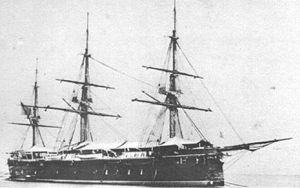The ironclad Zaragoza was a Royal Spanish Navy (Armada Real) wooden-hulled armored frigate completed in 1868. She later served as a training ship and was stricken from the naval register in 1896.
 Zaragoza at anchor
| |
| History | |
|---|---|
| Name | Zaragoza |
| Namesake | Battle of Saragossa |
| Ordered | October 1860 |
| Builder | Arsenales de la Armada, Cartagena, Spain |
| Cost | 7,000,000 pesetas |
| Laid down | 4 October 1860 |
| Launched | 6 February 1867 |
| Completed | June 1868 |
| Commissioned | July 1868 |
| Stricken | 1896 |
| Fate | Scuttled, 1899 |
| General characteristics (as built) | |
| Type | Broadside ironclad |
| Displacement | 5,650 metric tons (5,560 long tons) |
| Length | 85.4 m (280 ft 2 in) |
| Beam | 16.6 m (54 ft 6 in) |
| Draft | 7.5 m (25 ft) |
| Installed power | |
| Propulsion | 1 shaft; trunk steam engine |
| Sail plan | Ship rig |
| Speed | about 8 knots (15 km/h; 9.2 mph) |
| Complement | 548 |
| Armament |
|
| Armor | |
Design and description
editZaragoza was 85.4 meters (280 ft 2 in) long at the waterline, had a beam of 16.6 meters (54 ft 6 in) and a draft of 7.5 meters (24 ft 7 in). She displaced 5,650 metric tons (5,561 long tons). Her crew consisted of 548 officers and enlisted men.[1]
The ship was fitted with a pair of imported John Penn and Sons trunk steam engines that drove one propeller shaft using steam provided by six cylindrical boilers.[2] The engines were rated at a total of 800 nominal horsepower or 3,000 indicated horsepower (2,200 kW) and gave Zaragosa a speed of 12.5 knots (23.2 km/h; 14.4 mph)[1] The ironclad carried a maximum of 690 metric tons (679 long tons) of coal.[3] She was fitted with a three-masted ship rig with a sail area of around 1,800–1,900 square meters (19,000–20,000 sq ft).[4] The ship had a cost of 7,096,460 pesetas.
The frigate's main battery was originally intended to consist of thirty 200-millimeter (7.9 in) smoothbore guns mounted on the broadside, but she was completed with four 280-millimeter (11 in) and fourteen 200-millimeter guns, all smoothbores, on the gun deck. On the main deck above them were two 220-millimeter (8.7 in) smoothbores, one on each broadside, and another in the forecastle as the forward chase gun. By 1883, the smoothbore guns had been replaced by rifled muzzle-loading (RML) guns. Four Armstrong-Whitworth 229-millimeter (9.0 in) and eight 160-millimeter (6.3 in) Palliser guns were located on the gun deck and three 180-millimeter (7.1 in) Palliser guns were mounted on the main deck.[5]
Zaragosa had a complete wrought iron waterline belt that ranged in thickness from 102 to 130 millimeters (4.0 to 5.1 in). Above the belt, the guns, except for the chase gun, were protected by 110-millimeter (4.3 in) armor plates. The ends of the ship and the deck were unarmored.[2][6]
Construction and career
editZaragoza was laid down by Arsenales de la Armada in Cartagena, on 4 October 1861. Her construction period was lengthy, and she was not launched until 6 February 1867. She was completed in June 1868 and commissioned in July 1868.[7]
Zaragoza saw action in the Third Carlist War of 1872–1876.[8] She underwent a major overhaul in 1889.[7] In 1892, she was relegated to use as a torpedo training ship at Cartagena.[7] She was stricken in 1896 and scuttled in 1899.[7]
Footnotes
editReferences
edit- Brassey, Thomas (1888). The Naval Annual 1887. Portsmouth, England: J. Griffin. OCLC 669097244.
- de Saint Hubert, Christian (1984). "Early Spanish Steam Warships, Part II". Warship International. XXI (1): 21–45. ISSN 0043-0374.
- Lyon, Hugh (1979). "Spain". In Chesneau, Roger & Kolesnik, Eugene M. (eds.). Conway's All the World's Fighting Ships 1860–1905. Greenwich, UK: Conway Maritime Press. pp. 380–386. ISBN 0-8317-0302-4.
- Silverstone, Paul H. (1984). Directory of the World's Capital Ships. New York: Hippocrene Books. ISBN 0-88254-979-0.